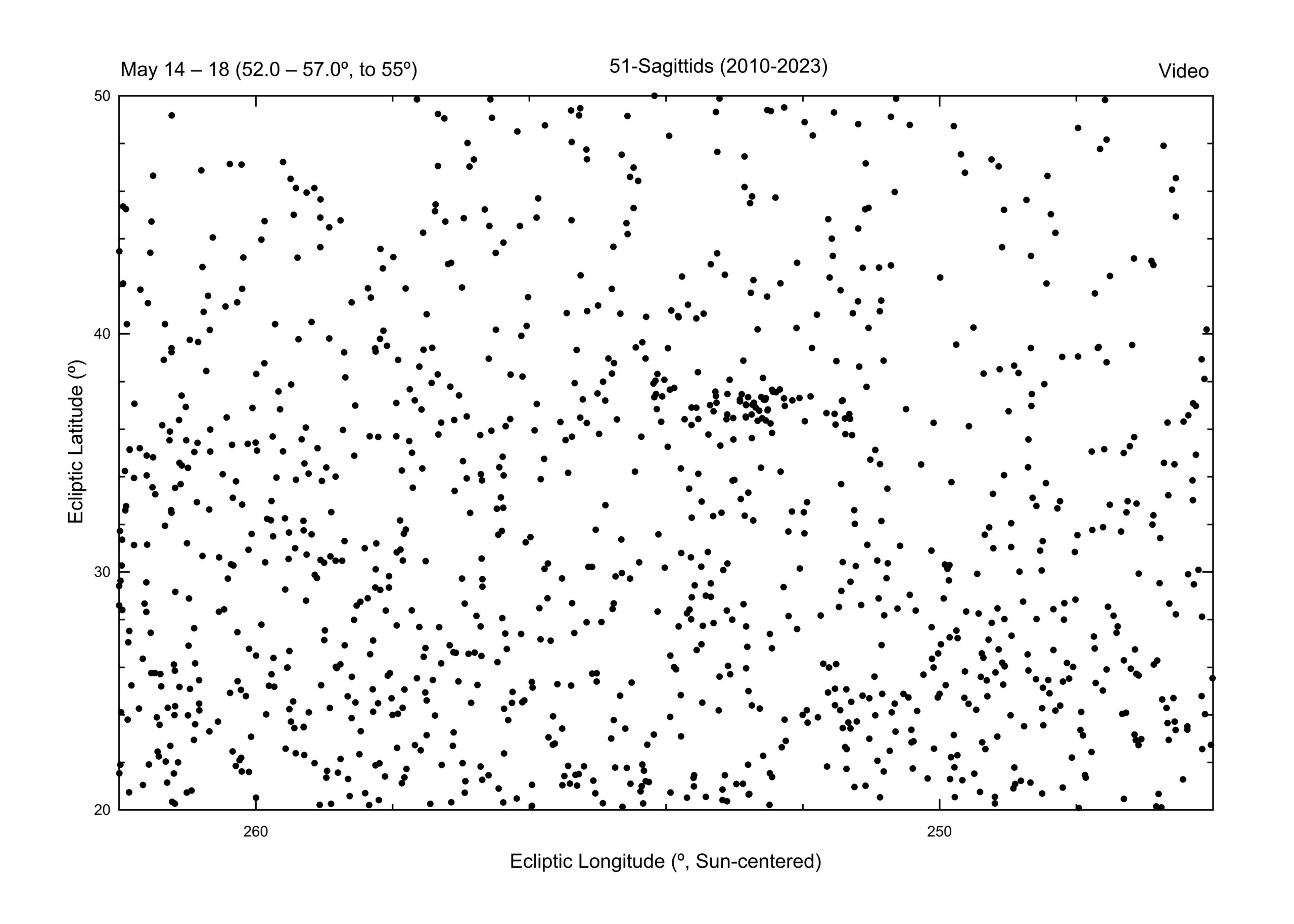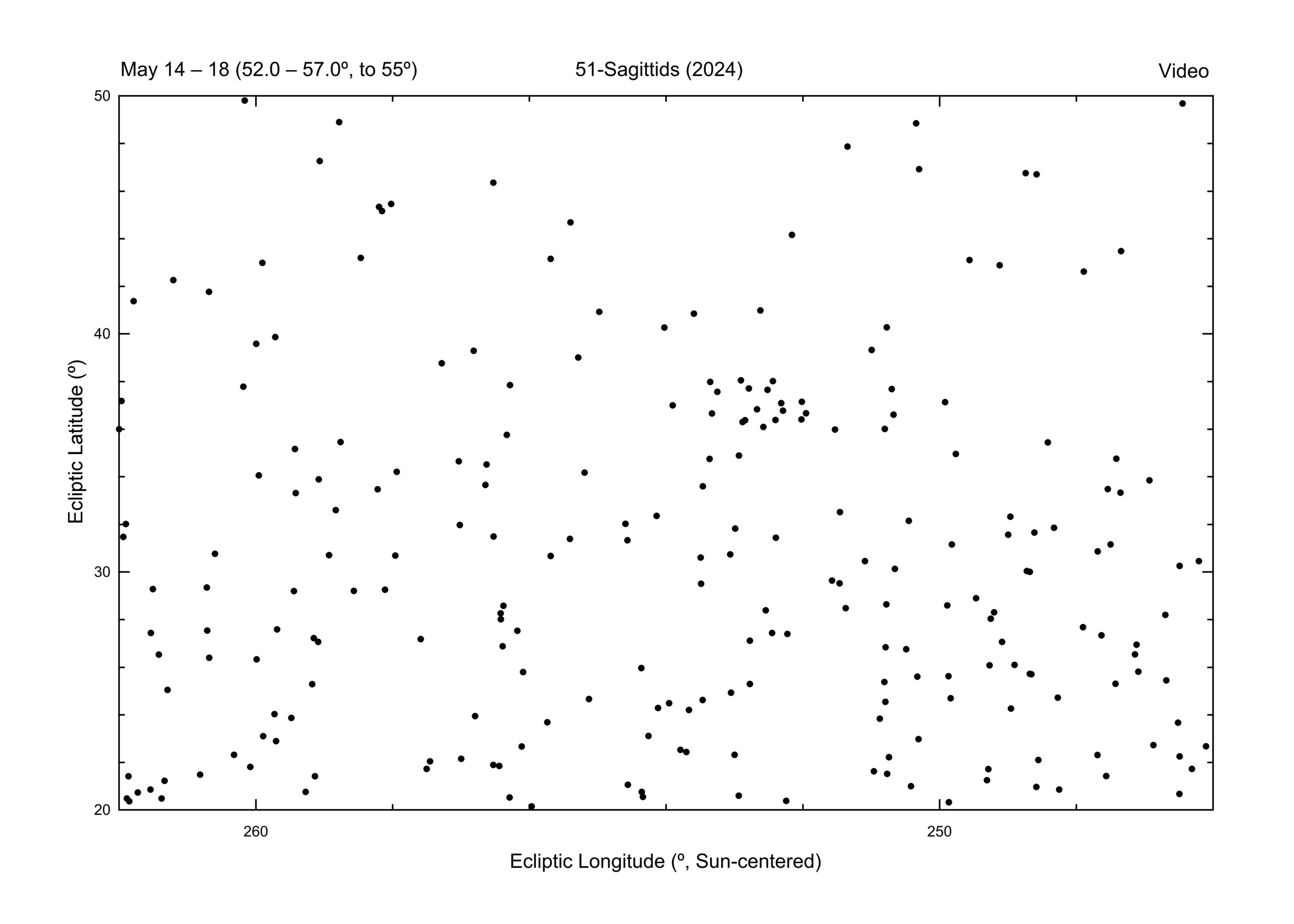By: P. Jenniskens, M. Odeh, C. Johannink, M. Breukers, J. Baggaley, J. Scott, N. Moskovitz, T. Cooper, H. Devillepoix, D. Rollinson, and D. Samuels.
Abstract: The newly detected 51-Sagittids shower reported last year from Global Meteor Network observations was visible in single night CAMS data for May 14/15, 2024. The shower appears to be a weak annual shower from a yet-to-be-discovered long-period comet. The shower was also detected by CAMS in prior years.
Introduction
Last year, Vida et al. (2023) reported the detection by the Global Meteor Network of a possible new shower with a radiant in Sagitta on a single night in May. The shower was designated M2023-K1. Subsequently, the shower was given the provisional name 51-Sagittids and Lunsford (2024) called attention to the shower in the weekly shower call for new observations. When the shower was clearly detected in single-night CAMS data this year at the website http://cams.seti.org/FDL/, Lunsford alerted us to this confirmation. Here, we report on that detection, confirming it as a sighting of a yet-to-be-discovered long-period comet.

Figure 1 – Radiant map in the region around the 51-Sagittids radiant during the shower’s activity period from past 2010-2023 CAMS observations (Jenniskens, 2023).
Observations
Figure 1 shows the radiants of meteors detected in the CAMS network during the 5-day solar longitude interval 52 – 57 degrees (Equinox J2000), roughly corresponding to the dates of May 14-18. The radiants are given in Sun-centered ecliptic coordinates and plotted similar to such maps in Jenniskens (2023). The shower is clearly detected as a concentration of radiants in the northern apex source. The radiant distribution shows a daily drift in Sun-centered coordinates and sharpens up slightly after correction (Jenniskens, 2023), the result shown here. Vida et al. (2023) already reported that the shower was detected in prior years of the Global Meteor Network as well as in the results from the SonotaCo and EDMOND low-light video camera networks.

Figure 2 – Same as Fig. 1, but for the CAMS observations in 2024.
Figure 2 shows the data from the CAMS networks in 2024 in a similar plot. The shower is clearly detected. Table 1 gives the median orbital elements and their 1-sigma dispersion. The first meteor was detected on May 14 at 18h38m UTC, and the shower was last seen on May 17 at 01h11m UTC.
The shower is very weak and observations are from a number of CAMS networks, mostly reflecting the local weather conditions. 6 meteors were detected by the United Arab Emirates Astronomical Camera Network, coordinated by M. Odeh. 5 meteors were detected by CAMS BeNeLux, coordinated by C. Johannink and M. Breukers. 3 meteors were detected by CAMS New Zealand, coordinated by J. Baggaley (University of Canterbury) and J. Scott (University of Otago). 3 meteors were detected by LO-CAMS, coordinated by N. Moskovitz (Lowell Observatory). 1 meteor was detected by CAMS South Africa, coordinated by T. Cooper, and 1 meteor was detected by CAMS Australia, coordinated by H. Devillepoix (Curtin University) and D. Rollinson.
Table 1 – The median orbital elements (Equinox J2000.0) of the 51-Sagittids compared to the 2023 observations reported by Vida et al. (2023).
| 51-Sagittids
GMN: 2023 |
51-Sagittids
CAMS: 2010-2023 |
51-Sagittids
CAMS: 2024 |
|
| λʘ (°) | 54.5 | 54.8 ± 1.1 | 54.4 ± 0.6 |
| αg (°) | 300.3 | 300.7 ± 1.6 | 300.1 ± 1.1 |
| δg (°) | +17.8 | +17.4 ± 0.7 | +17.2 ± 0.7 |
| vg (km/s) | 59.7 | 59.2 ± 1.2 | 58.9 ±. 1.2 |
| λ – λʘ (°) | 252.8 | 252.8 ± 1.0 | 252.3 ± 1.1 |
| β (°) | +37.4 | +37.0 ± 0.7 | +37.0 ± 0.6 |
| a (AU) | 300.9 | 17.7 | 12.6 |
| q (AU) | 0.903 | 0.897 ± 0.015 | 0.891 ± 0.018 |
| e | 0.997 | 0.949 ± 0.085 | 0.929 ± 0.093 |
| ω (°) | 218.2 | 219.4 ± 3.2 | 220.6 ± 3.8 |
| Ω (°) | 54.4 | 54.7 ± 1.1 | 54.4 ± 0.6 |
| i (°) | 113.5 | 113.9 ± 1.4 | 113.4 ± 1.2 |
| Π (°) | 272.6 | 274.6 ± 2.9 | 275.9 ± 3.8 |
| Tj | -0.45 | -0.23 | -0.07 |
| N | 15 | 65 | 19 |
Discussion
Observations in 2024 do not suggest that there was an outburst. The number of detected meteors was, starting in 2011: 0, 3, 1, 1, 0, 0, 2, 6, 5, 11, 7, 6, 8, and 19. The increase in the number over the years reflects the increasing number of cameras deployed. This appears to be an annual shower. In prior years, the shower was first detected as early as May 14 at 7h28m UTC and last seen on May 18 at 8h24m UTC. The median solar longitude of this year’s observations was at a similar time to that of prior years (Table 1).
The relatively high semi-major axis points to a long-period comet being the source of this shower. The orbital period is likely more than 250 years and less than 4,000 years (Jenniskens et al., 2021). In the coming years, it deserves to pay attention to this radiant to see if outbursts can be detected. At present, we know that the source is a long-period comet. If the 1-revolution dust trail of this comet wanders in Earth’s path on occasion, which is expected to happen only once or twice every 60 years if the comet orbit passes close enough to Earth (Lyytinen & Jenniskens, 2003), then this would make this comet a Potentially Hazardous Comet.
References
Jenniskens P., et al. (2021). ” Meteor showers from long-period comets.” Icarus 365, article id.114469.
Jenniskens P. (2023). “Atlas of Earth’s Meteor Showers.” Elsevier, USA. 838 pp.
Lunsford B. (2024). “Meteor activity outlook for May 11-17, 2024.” American Meteor Society website: https://www.amsmeteors.org/2024/05/meteor-activity-outlook-for-may-11-17-2024/ (last accessed May 22, 2024).
Lyytinen E., Jenniskens P. (2003). “Meteor outbursts from long-period comet dust trails.” Icarus 162, 443–452.
Vida D., Segon D., Roggemans P. (2023). “A possible new meteor shower in Sagitta.” eMeteorNews 8, 246–251.





